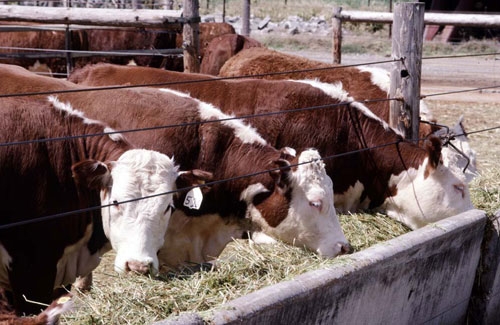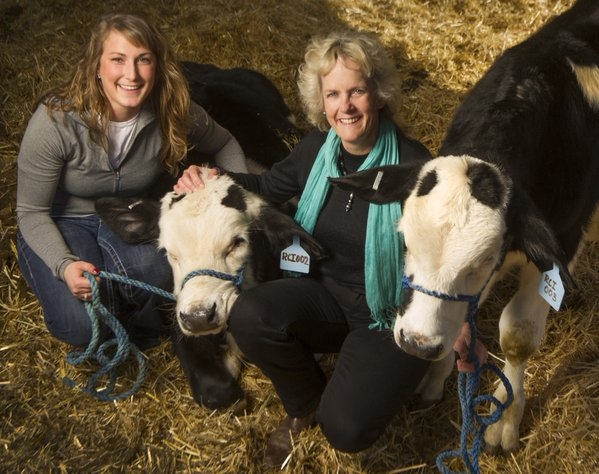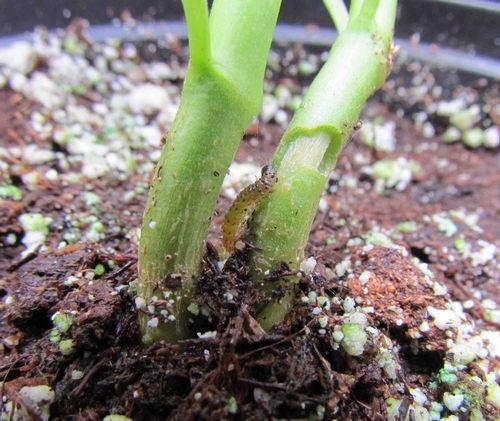Posts Tagged: cattle
Impact of grazing livestock on public lands under drought conditions
Poor management of grazed rangelands can "exacerbate the effect of drought," the report said.
The Forest Service identified the need to reduce cattle numbers on public land during a severe drought - in come cases to 50 or 70 percent of total carrying capacity, which is the number of animals the land can support before causing environmental degradation. Plants that have been overgrazed "are less able to recover after a drought," the report said.
For expert commentary, Danovich turned to a UC Agriculture and Natural Resources (UC ANR) source. Sheila Barry, the livestock and natural resources advisor for UC ANR Cooperative Extension, said ranchers do have to reduce herd size in times of extreme drought.
Cattle that graze on the open range are usually finished at a feed lot. In the first year of drought, ranchers have the option of weaning cattle early to reduce demands on the land without reducing the herd size. In the second year of drought, ranchers have to consider cutting into their herds. "As soon as they do that," Barry said, "it can take up to eight years to build it back."
Scientists using genetic editing to delete dairy cow horns
Dairy cows have been bred for optimal dairy production, but the gene mix brought along horns. Angus beef were bred for optimal beef production, and don't have horns. Since the dairy industry doesn't want animals with horns because they can hurt each other or farmworkers, it is common practice to remove them shortly after birth.
Removing the horns involves an uncomfortable procedure called debudding, in which, after being treated with a local anesthetic, the cells on the animal's head that would grow into horns are killed with an electrical appliance.
"Consumers are concerned about how we care for dairy animals. They expect us to do a good job and are concerned about pain and discomfort," said UC Davis veterinarian Terry Lehenbauer in a video about the advancement (See the video below).
Using precision genetic "editing," scientists were able to delete the dairy cow gene that produced horns and replace it with the angus gene that resulted in hornlessness.
At UC Davis, the two calves' growth and development will be tracked. Eventually they will father cows with horned mothers to see if the hornless trait is passed on to the offspring. The odds of them doing so, Van Eenennaam said, are 100 percent, if "Mendelian genetics hold true." Mendelian genetics are laws of gene inheritance discovered by 19th century monk Johann Mendel.
Van Eenennaam said it's not clear whether other, unexpected effects of the gene editing will occur. However, if successful, gene editing will allow the dairy industry to bypass decades of breeding for hornless cows.
Central Coast cattle industry suffering losses due to drought
Since the late 1700s, grazing has been the best use for the rolling hills and valleys of California's Central Coast, reported Louis Sahagun in the Los Angeles Times. However, because of the state's four-year drought, three-quarters of the cattle in San Luis Obispo County have been sold or taken out of state. The sell-off brought in a record $129 million last year.
"We see clearly what a bust cycle looks like," said Mark Battany, UC Agriculture and Natural Resources viticulture and soils advisor in SLO County. "Ranchers have no choice but to sell off their cows and rebuild the herd when the rain comes back."
Sahagun reported that ranchers in the area have suffered severe drought for centuries.
"During a drought that ended in 1864, some ranchers drove their herds off cliffs and into the ocean below to stop their suffering," the article said.
The current drought is leaving landowners few options. The county placed a two-year moratorium on new agriculture that depending on the aquifer, so rangeland can't be converted to vineyards at the moment.
"Ranchers are getting hit hard from every direction," said Royce Larsen, UC ANR natural resource watershed advisor in SLO County. "It's a grim and desperate outlook."
Other news over the weekend included:
Holy S***! Almonds require a ton of bees
Tom Philpott, Mother Jones, May 25, 2015
Growing almonds in California takes about 1.7 million bee hives, drawing a large fraction of the nation's available bee hives. Why don't they stay in California? The state is already home to 500,000 of the nation's 2.7 million hives, said Eric Mussen, UC ANR specialist emeritus based at UC Davis. The almond bloom is great for a few weeks, but in terms of year-round foraging, "California is already at or near its carrying capacity for honeybees," he said.
Farm Beat: Here is how hikers, cattle can coexist
John Holland, Modesto Bee, May 22, 2015
UC ANR released a five-page brochure last month that shows how hikers and other visitors can avoid conflicts with cattle that graze on public land. Cattle fatten up nicely when they can graze calmly – good for the rancher and good for the buyer of the meat down the line, the story said.
Cooling cattle; European pepper moth examined
For an article "Should Wyoming livestock and ag adjust to climate?" in the Billings Gazette, reporter Paul Murray sought information about livestock animals' response to warmer temperatures from Frank Mitloehner, UC Cooperative Extension Specialist in the Department of Animal Science at UC Davis. Mitloehner talked about ways animals can cool down and discussed shade, fans, sprinklers and even alternative cattle breeds. "We're seeing more and more extreme weather. That is a tendency we're seeing more and more often. That can stress animals. Similar to animals in the wild, that can impact animals' reproductive ability and their performance," he told the reporter.
European pepper moth widespread in California
Surendra Dara for Western Farm Press
Western Farm Press published this article about European pepper moth by Surendra Dara, UC Cooperative Extension farm advisor in Santa Barbara County. Dara explains that the European pepper moth has been reported in several central and southern California counties. The pest prefers to feed at the plant base of crops such as corn, peppers, tomatoes, squash, strawberries and some ornamental plants. Dara has been appointed to the national Technical Working Group for European pepper moth, along with UC Cooperative Extension colleagues James Bethke and Steve Tjosvold.
Dara also wrote about this pest and shared photos of it on the UC Strawberries and Vegetables blog.
Curing pneumonia in cattle
Bovine respiratory disease - pneumonia in cattle - is the most significant health problem for the beef industry. The disease annually results in the death of more than 1 million animals. In addition to these losses, beef producers spend a significant sum on disease-related medication and labor costs each year.
According to AgInfo.net, raising cattle for specific resistance to BRD was a hot topic at the Beef Improvement Federation Conference earlier this month in Bozeman, Mont. Attendees learned about research under way at UC Davis to find the genetic component to BRD resistance and, eventually, breed out this deadly disease.
This spring, UC Davis announced that USDA awarded the university $2.6 million to carry out research aimed at reducing the incidence of bovine respiratory disease. The goal of the newly funded research project is to integrate research, education and extension activities to improve diagnostics and develop cost-effective genomic and management approaches that reduce the incidence of the BRD in beef and dairy cattle.
The extension component of the project is headed by Alison Van Eenennaam, Cooperative Extension specialist in animal genomics and biotechnology in the UC Davis Department of Animal Science. Van Eenennaam made a presentation at the Bozeman conference about the weight cattle producers should be give to BRD resistance when making selection decisions.

Twenty-nine percent of beef cattle deaths are associated with bovine respiratory disease.




